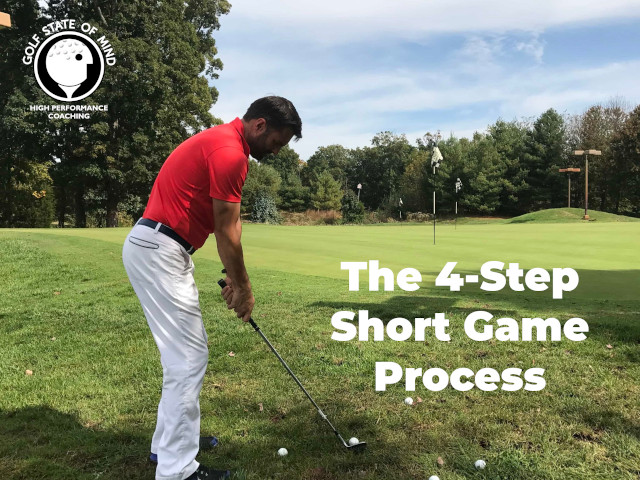
Click “Listen in browser” to listen to the audio.
In this week’s lesson, we’re going to take a look at how improving your short game “process” can massively improve your success on the course.
It’s amazing how many golfers tell me how “great” they are in practice but how little of that greatness transfers to the golf course.
Where is your focus?
A lot of this has to do with focus. In practice, where there are no real consequences to missing a shot, the mind is immersed in the process of hitting the shot (picking the target, visualizing and rehearsing the shot, etc.) with little thinking going on over the ball. On the course, where the player is more concerned about the outcome, they feel pressure to play a good shot. This shift of focus causes the following changes:
- It activates the nervous system (increasing heart rate, tension and making focus harder)
- It brings attention to what the player is in fear of (not getting up and down, miss-hitting it, what they will look like to others)
- It reduces the players connection with the look and feel of the shot (the intention)
- It causes more “internal focus” on what the body is doing and less “external focus”
These changes affect both the connection with the shot and the messages being sent to the muscles, and explain why they play less of those “great” shots that they hit in practice.
What is a “Process”?
A process is something you do irrespective of outcome, but gives you the best chance of getting the desired outcome. No matter how good your skills are in golf, you have to accept that you will never have complete control of the outcome. For any round of golf, you need to be able to focus on process, and let the outcome take care of itself. But this isn’t as easy as it sounds and requires practice.
Focus is probably the most important thing you can improve to play better on the course. This is why I created my “mental game scorecard”, which forms the basis of my mental game training program, as it holds you accountable to your process before, during and after your shots. When we make process the goal, we lower performance anxiety and distraction, and you are more free to engage with the intention for the shot you have in front of you.
The Short Game Process
Let’s take a look at the steps of the optimal short game process.
Phase 1: The Thinking (or “Decision”) Phase
What is the best shot to play? This is determined by factors such as lie, slope, amount of green to work with, wind etc. Generally speaking, (if possible) you should get the ball rolling on the green as quickly as possible.
Phase 2: The Rehearsal Phase
The short game is too much about finesse and use of fine motor skills for you to think about the action while doing it. Instead, we need to connect with the look and feel of the shot before we play it. This tells the movement centers of the brain which muscles to use to play that particular shot.
I’m sure you’ve noticed that when your short game is at its best, it’s when you are using your imagination to visualize the shot and imagining/rehearsing how the shot will feel. The rehearsal phase is about creating a feeling for the visual image of the shot (trajectory, landing area, roll out and “seeing” the ball go in).
Phase 3: The Engagement (or “Athletic”) Phase
It’s highly important to stay focused on the anticipated “feels” for the shot when over the ball, instead of allowing thoughts to interfere. When you watch Tour players on the TV, you’ll notice that when they are over the ball getting ready to play the shot, they are constantly glancing at the target (and seeing the shot in their mind’s eye). For many amateurs, they get static, staring down at the ball and disconnecting from the intention for the shot. I call this the athletic phase, because when you’re athletic, you’re reacting, not being proactive and static.
Phase 4: The Post Shot Routine
If the shot was good or good enough, be happy about it and anchor it. If you didn’t play the shot as well as you would have liked, evaluate your short game process and see if there was something in it that you could have done better (focus, commitment, golf IQ, etc). Once you’ve done that, put it behind you quickly and get back to the present moment.
Practicing the short game
I’m not discounting learning the proper techniques to play different shots (personally I love James Sieckmann’s stuff), but too many golfers don’t do enough variable and competitive practice. By variable practice, I mean playing a different shot each time (different lie, trajectory, carry, club etc). This is how you learn the feels for different shots. By competitive practice, I mean giving yourself challenges to complete during every practice session, so you have consequences and pressure. During these challenges, you train yourself to focus on the process (and figure out what it needs to be), just as you would on the course. Add space between each shot (like you have on the course) and increase your heart rate by running on the spot.
A sample short game drill
1. Select 3 locations around the green (within 20 yards of the hole), 1 with a tight lie, one normal and one rough lie. One should be on an upslope, one flat and one on a downslope.
2. Hit 2 shots from each location with different trajectories and try to get them within 6 ft of the hole
From the first location, identify your landing spot on the green and place a tee where it will be. Once you a shot within 3ft of this landing spot and within 6ft of the hole, move onto the next shot.
3. Identify your next landing spot for the next trajectory. When you get it within 3ft of your landing spot and 6ft of the hole, move onto the next location.
4. Repeat from the different lie. The challenge is complete when you’ve successfully hit all 6 shots within 6ft of the hole and within 3ft of your landing spot (you can change the “Challenge Point” of this drill depending on your skill levl but it should be a challenge!).
If you’d like a full range of different short game drills, please check out the training program.
Next time you’re practicing or playing, notice where your focus is during your short game shots and stick to the 4 phases of the short game process. If you can do so, I’m confident you’ll see improvement.


